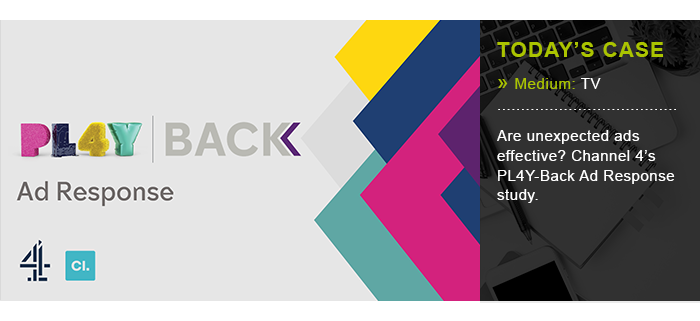| Click here to view this e-mail in your browser |
|
|||||||
| Business case studies | No 291 - 28.02.2020 |
 |
While creative solutions are often the ideal way for TV companies to attract new advertisers, it sometimes remains challenging to prove to clients and brands that their investments in a channel’s creative formats are paying off. This week’s egtabite features the PL4Y-Back Ad Response study conducted by Channel 4, which proves that the creative use of ad breaks can drive implicit attention, cognitive engagement and explicit response through eye-tracking technology, physiological responses, and more traditional surveying methods. PL4Y-Back project To show clients that their investment is effective, Channel 4 built a framework of research to successfully measure the impact of exposure, which turned out to be more efficient, less costly and more comparable (due to its standardised questions) than other studies conducted in the past. Channel 4’s PL4Y-Back project was created in collaboration with the independent research agency Consumer Insight with the goal to build a normalised dataset around how Channel 4’s most innovative advertising break solutions deliver for their audience. The channel created an experiment to test how well ads with “unexpected” messages perform. The aim was to look at brand expectations and how this impacts explicit measures such as ad effectiveness as well as the cognitive effort and engagement of viewers. The project methodology applied eye-tracking technology, physiological and more traditional surveying methods. In addition to viewers’ explicit and conscious response, their physiological responses such as fixations per second, galvanic skin response (arousal and cognitive load) and heart rate were monitored using an eye-tracking camera. The participants of the study were shown three different types of ads from 38 different brands in a lab-created ad break environment. The first was so-called expected ads that Channel 4 used from the PL4Y-Back database which resulted in an average “expectedness score” of 65% (meaning that 65% of people, on average, say that the ad is what they would expect from the brand). The other type of ads showed during the ad break were unexpected ads, which scored below the score of expectedness for a certain brand along (completely out of ordinary for the brand) with the third category called filler ads. For instance, one of the unexpected ads showed was the campaign with drag queens for British cider brand Bulmers, with a punchline Bursting with British variety, which shocked respondents but also kept their attention. |
Unexpected ads work, but…
The results of the PL4Y-Back study were threefold. First, as unexpected ads were more committed to the memory and capturing attention, participants remembered 4.7 out of 5 unexpected ads, while only 3.8 out of 5 of the expected ads were recalled. This proves that standing out aspect of the ad is beneficial to advertising, as it is more trustworthy and innovative.
Second, unexpected ads evoke a polarising response among participants, as they are more likely to be strongly liked but also strongly disliked. On the other hand, according to the study, expected ads leave viewers indifferent. Moreover, the unexpected ads scored the highest heart rate among the respondents (8.5% higher than for the expected ads), boosting arousal and visual perception. The results indicate that the strong appeal to attitudes of unexpected ads is a risk which advertisers should take because there is a high chance, they will get it right and have their ads remembered and loved.
However, the third takeaway of the PL4Y-Back study revealed an issue in unexpected ads, as they proved to be a weak connection to the brand and quite difficult to link it to the company’s values. Therefore, unexpected ads, memorable on its own, scored lower in brand recall than expected ads that were easily connected to the brand, which can be rather problematic for advertisers. In order to work, unexpected ads need to create a strong link to the brand and stay true to its DNA.
The example of the Bulmers ad is effective as it has unusual content, giving both expected and unexpected flavors yet it is contextually linked to the programme where it was aired while remaining consistent with the brand image.
Takeaways for the future
Channel 4’s PL4Y-Back project provides several takeaways:
The more an ad stands out, the more the brand image is boosted – as long as the execution stays true to the brand’s DNA. When ads are seen as more relevant, they are more likely to improve people’s opinion of the brand and to persuade viewers to buy. When an ad plays to brand norms, it is better perceived by the audience who is then more likely to purchase its products.
Finally, creativity should always be encouraged, as long as those unexpected solutions are linked to the brand, otherwise, engagement is wasted.
“We continue to explore the relationship between ad effectiveness and creative use of our airtime as we know from the work of the IPA’s Binet and Field, that creative triggers which resonate with the audience are a major driver of large business effects. Our own work is key in helping advertisers understand how to make executions which have the maximum impact on the audience”, said Martin Greenbank, Head of Advertising Research & Development at Channel 4.
|
|
|
|
|
|
|
|
|
|
|
|
|
|
|
|
|
Privacy policy: Please note you have the right to manage your mailing preferences at any time by: > Visiting our Mailings Subscriptions Page or > Contacting us directly at [email protected]. |
egta - 22, Rue des Comédiens, boîte 4 - 1000 Brussels - T: + 32 2 290 31 31 - www.egta.com |


